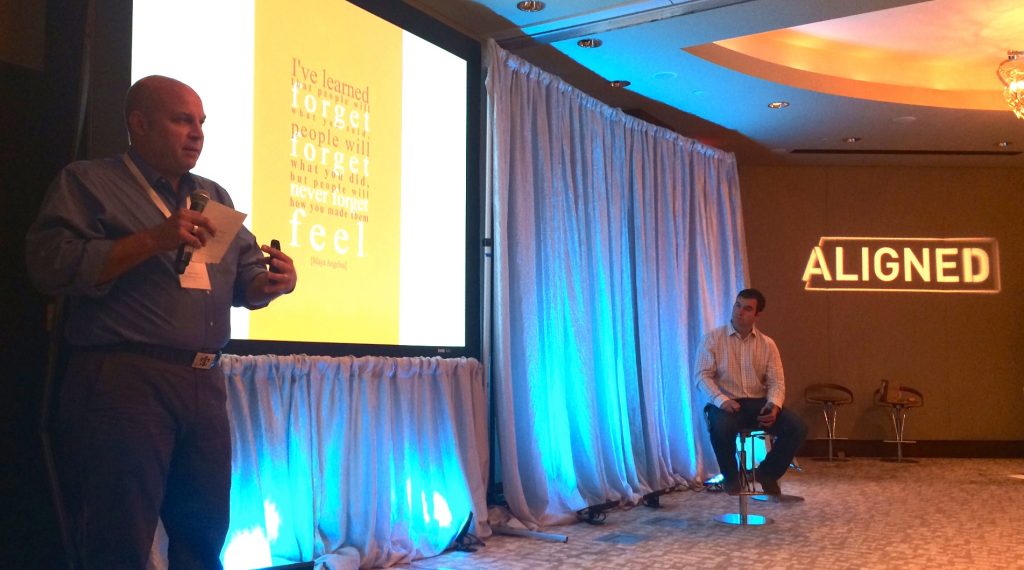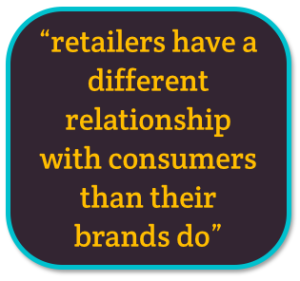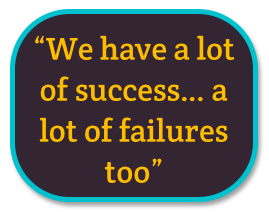
 John Ross of PepsiCo caught everyone’s attention when he started his presentation at this year’s #AlignedCon by showing a photo of a skydiver who was falling backward toward earth. Far below him, we could make out the outline of the cars and RVs parked in rows at the Burning Man symposium in Nevada. The man was wearing a pair of multicolored, reflective neon pants that have recently been introduced by a small start-up.
John Ross of PepsiCo caught everyone’s attention when he started his presentation at this year’s #AlignedCon by showing a photo of a skydiver who was falling backward toward earth. Far below him, we could make out the outline of the cars and RVs parked in rows at the Burning Man symposium in Nevada. The man was wearing a pair of multicolored, reflective neon pants that have recently been introduced by a small start-up.
John shared this photo that went viral to highlight the three major requirements for what engaging content should be. The photo is contagious because people want to share it. It has social influence because it is so appealing that customers have posted it on many social sites, sharing it with their networks. It is also capable of generating loyalty and frequency, because it will continue to appeal to its brand influencers for a long time.
How can you get your content to hit all three of those moving targets? And how do you, as a marketer, get your regional dealers to engage with your content and promote it? John went on to provide insight:
“Content, and syndicated content, has become the greatest opportunity for reaching independent customers and it’s really the rise of mobile that has done that. Only a few years ago, we were aware that we were shipping merchandise and at the same time, 60% of it never got put up in stores. At the same time,  customers never felt that they were getting digital content. And they wanted to act in ways that are similar to some of our brands. But retailers have a different relationship with consumers than their brands do. Trying to bridge that gap through content is a big part of my responsibility and my team’s responsibility at PepsiCo.
customers never felt that they were getting digital content. And they wanted to act in ways that are similar to some of our brands. But retailers have a different relationship with consumers than their brands do. Trying to bridge that gap through content is a big part of my responsibility and my team’s responsibility at PepsiCo.
Just so we’re clear – at PepsiCo, we have 22 one-billion dollar class brands. Everybody knows about Pepsi and Mountain Dew, but we also have Sabra Hummus, Tropicana, Doritos and Tostitos. We also have Quaker Oats and other brands. All of them are at different stages of digital strategy. Depending on what the needs are for the brands, we have to figure it all out and devise the right social strategies. I focus purely on customer engagements – solutions across different parts of the marketing organization.
PepsiCo’s brands have always taken a lot of risk to be creative. We have had a lot of success,
a lot of failures too. At meetings, our CEO will often have members of the marketing teams stand up and talk about the biggest thing that has gone wrong, or the biggest mistakes they have made.
 One executive on our brand team is the man who was behind Crystal Pepsi. He told us that the retailers told him that it would fail. Pepsi did focus groups and testing and thought that it was going to be the coolest thing – but the retailers were saying, `this is dead on arrival.’ You have to listen to your retailers and get insights and feedback about what is happening on the street level.
One executive on our brand team is the man who was behind Crystal Pepsi. He told us that the retailers told him that it would fail. Pepsi did focus groups and testing and thought that it was going to be the coolest thing – but the retailers were saying, `this is dead on arrival.’ You have to listen to your retailers and get insights and feedback about what is happening on the street level.
Let’s talk again about that picture of the guy jumping out of the plane above Burning Man. The company that made the reflective disco pants he was wearing published that photo on their website and then people all over the place started taking pictures of themselves wearing these pants. So we started to ask how quickly and how cheaply we could generate content. For that company, the average cost is about $350 per video. Coming from Pepsi, I don’t necessarily have to figure out how to create content if I can get it from the retailers and then can sell it back into the brand to get national reach. That’s how my job has evolved. Because if I get great content back from the retailers, I can syndicate it back out across customer channels.
Kyrie Irving did a deal [for Pepsi Max] of putting on makeup as an 85-year-old man, and then playing basketball on a public court. That video generated 34 million views on YouTube, without paying a penny for it. And that changed how we started to think about generating content and who we would connect to. It worked.
Doing surprise and delight type videos, a lot of these PR stunts, works well. The surprise and delight stuff, that’s fun. But we also have to think about how we provide information digitally and how we distribute that content. If I can get consumers engaged in content in the retail environment, that’s what is going to continue to drive the frequency metrics – but if I can improve my retailer – then I am on the path to success.
So there are three main pillars for engagement:
John Ross is Director of Customer Solutions, Digital Integrated Media Team, PepsiCo. John joined PepsiCo in 2012 to help lead Customer Solutions development through the Digital Engagement Team. His responsibility oversees all brand engagements with shopper, foodservice customers, and e-commerce digital customer relationships. Top volume PepsiCo customers represent a footprint of more than 300,000 customer locations nationally.
